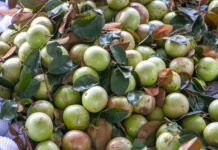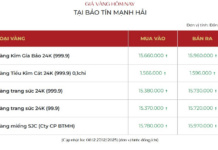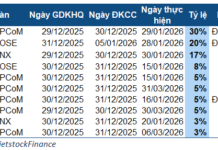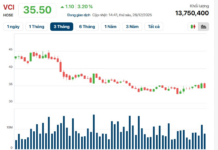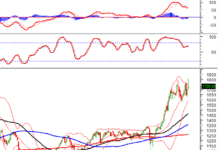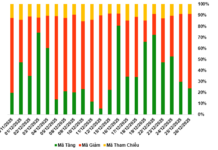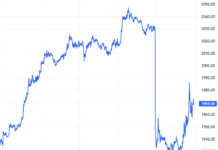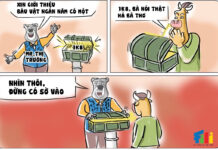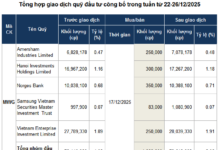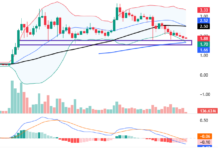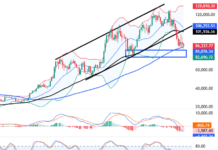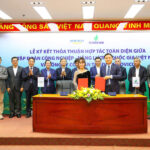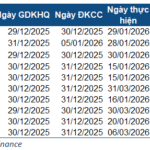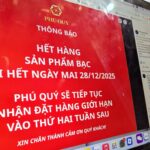Vietnam’s Rice Export Industry: Navigating Challenges and Exploring New Markets
According to the Thai Rice Exporters Association, in the first half of 2025, Vietnam surpassed Thailand to become the second-largest rice exporter in the world. Specifically, Vietnam exported 4.72 million tons of rice, second only to India (11.68 million tons), while Thailand fell behind with 3.73 million tons due to higher selling prices affecting its competitiveness.
Increasing Volume but Decreasing Value
Meanwhile, a report from the Ministry of Agriculture and Environment showed that rice exports in July 2025 are estimated at 750,000 tons, valued at over $366 million.
Cumulatively, in the first seven months of 2025, Vietnam exported 5.5 million tons of rice, earning $2.81 billion – an increase of 3.1% in volume but a decrease of nearly 16% in value compared to the same period in 2024. This decrease is mainly due to the average export price of rice falling by 18.4%, to around $514 per ton, as India, the world’s largest rice exporter, returned to the market, creating price competition.
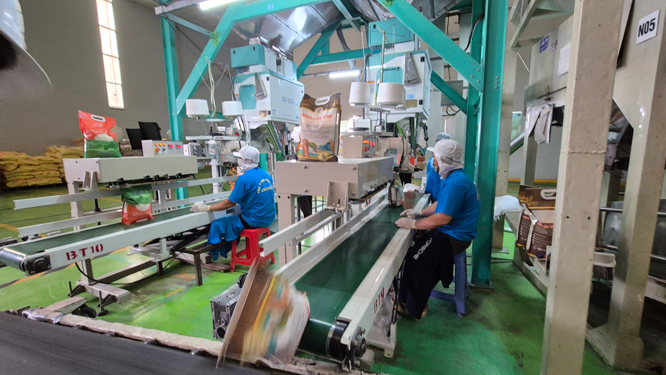
Inside a rice processing factory in An Giang. Photo: NGOC ANH
The Philippines remains the largest consumer market for Vietnamese rice, with a market share of up to 42.6%. The next largest markets are Ghana (11.1%) and Ivory Coast (10.6%). Notably, Bangladesh recorded the strongest growth – a whopping 188 times higher than the same period last year, while exports to Malaysia plummeted by 58.5%.
Mr. Do Ha Nam, Chairman of the Vietnam Food Association (VFA), assessed that with the current export momentum, the country can completely achieve the target of 7.9-8 million tons for the whole year. He stated that the quality of Vietnamese rice is high, with about 70% being fragrant rice.
“Some recent information about the price of Vietnamese 5% white rice being below $400 per ton is incorrect. As the head of the VFA, I will rectify this, especially on the VFA website, to ensure information accuracy,” emphasized the VFA Chairman.
However, Mr. Phan Van Co, Marketing Director of Vrice Rice Company, observed that the rice export market remains subdued as traditional partners tend to reduce imports and strengthen trade protectionism. For example, the Philippines has imposed additional technical barriers and is considering import taxes; recently, there has been news that this market will temporarily suspend rice imports for 60 days… to protect domestic production.
According to Mr. Phan Van Co, the above information makes traders anxious, leading to a decrease in rice imports compared to previous years. “If in the past, enterprises received large orders for 3-6 months, now they only receive monthly orders with small volumes because partners are cautious about the changes in the policies of their respective governments and global economic and political fluctuations,” he assessed.
Mr. Nguyen Vinh Trong, Director of Viet Hung Company (Dong Thap), said that he is still verifying information from Philippine partners. However, this information immediately affected the market, causing the price of Dai Thom 8 rice – the main export item to the Philippines – to decrease slightly by about $5-10 per ton.
Nevertheless, Mr. Nguyen Vinh Trong believed that if the Philippines’ new policy is implemented, it would not have a very negative impact. This is because more than 70% of Vietnam’s summer-autumn rice has been consumed, and there is almost no harvest in September-October, so there will be no pressure to sell.
Focusing on Market Expansion
In the face of the aforementioned challenges, market expansion is considered a vital factor in the export of Vietnamese rice.
According to the Vietnam Trade Office in Singapore, this market maintains stable imports and is considering signing a bilateral trade agreement on rice with Vietnam, facilitating exports in the coming time. In Europe, thanks to the Free Trade Agreement between Vietnam and the European Union (EVFTA), Vietnamese rice has a price advantage over Thailand, India, and Cambodia. However, to seize this opportunity, Vietnam needs to negotiate an increase in the export quota to the EU, which currently stands at 80,000 tons per year.
In Austria, the Vietnam Trade Office has connected the 3Brothers Company to import Vietnamese sushi rice in 10kg packages, which are well-received by customers. With the trend of green and sustainable consumption, the demand for high-quality, safe, and environmentally friendly agricultural products in Austria is expected to increase significantly in the coming time.
Regarding long-term prospects, Mr. Duong Duc Quang, Deputy General Director of the Vietnam Commodity Exchange (MXV), stated that with the advantage of quality and the Vietnamese rice brand already affirmed in the international market, enterprises should promote brand building and trade promotion. They need to expand consumer markets, not only in traditional regions such as Southeast Asia but also towards new markets in Europe, America, and Africa. In addition, optimizing the supply chain and improving logistics efficiency are crucial to reducing costs and coping with short-term price fluctuations.
“Once the high-quality input chain is stable, the entire rice industry, including processing and exporting enterprises, will benefit and develop sustainably,” emphasized Mr. Quang.
Meanwhile, Mr. Phan Van Co suggested that authorities consider restricting rice imports into Vietnam. He explained that importing average varieties for re-export would affect the quality and reputation of Vietnamese rice globally.
“Vietnam mainly imports rice from India and Cambodia. In particular, white rice from India, when including transportation costs and other fees, is priced similarly to domestic rice when it reaches Vietnam, offering no competitive advantage,” Mr. Co remarked.
In addition, rice export enterprises are also awaiting adjustments in value-added tax (VAT) policies. An enterprise owner shared that from the end of July up to now, export orders to the US, Australia, etc., have been temporarily halted due to concerns about VAT refund difficulties. Previously, enterprises still had inventory eligible for 0% tax under the old regulations, but now, new goods are subject to 5% tax, disrupting cash flow due to suspended refunds. Therefore, agricultural associations have simultaneously proposed policy amendments to avoid adding financial pressure to enterprises.
“Rice export enterprises often have to make advance payments to purchase goods from farmers, and it takes about a month to receive payment after exporting. If they have to pay 5% VAT in advance, it will lead to a disruption in cash flow,” analyzed the representative of Vrice Rice Company.
Importing Does Not Mean a Lack of Rice
Alongside some difficulties in exports, Vietnam’s rice industry is witnessing a strong upward trend in imports. In the first seven months of 2025, the import value of rice reached nearly $1 billion, reducing the trade surplus of the industry to $1.81 billion – a decrease of 30% compared to the same period last year.
According to forecasts from the US Department of Agriculture (USDA), Vietnam may surpass Indonesia to become the second-largest rice importer in the world this year, with a volume of up to 4.1 million tons. The reason is attributed to reduced domestic production and increased demand for cheap rice from Cambodia.
However, Mr. Do Ha Nam believed that this data does not accurately reflect the reality. According to him, the USDA counts both rice and paddy, while the rice recovery rate from paddy is only about 55%. He affirmed, “Vietnam imports not because of a rice shortage but to serve export processing, bringing overall benefits.”
Most of the paddy is imported from Cambodia, including sources from land leased by Vietnamese people. Additionally, Vietnam also imports dry rice from India for making vermicelli and cakes, as this type of rice is becoming rarer domestically. However, recently, due to the decrease in domestic rice prices and exchange rate fluctuations, many enterprises have temporarily stopped importing as it is no longer profitable.
Toyota Vios: Massive Discounts, Now Even Cheaper than the Grand i10!
Introducing the all-new Toyota Vios – an exceptional vehicle that offers more than just a smooth ride. Our trusted dealers are offering an exclusive deal, providing not just cash incentives but also a range of exciting accessories to enhance your Vios experience. Step into a world of style, comfort, and convenience with this incredible offer.
“Comprehensive Collaboration Between Petrovietnam and Sovico: A New Impetus for Energy and Economic Development”
With a renewed mission and vision for its new phase of development, the Vietnam National Oil and Gas Group (Petrovietnam) is seeking to expand its collaborations with leading domestic and international enterprises, particularly private sector businesses. This strategic move aims to foster sustainable energy and economic growth in the country.
“Leading Brazilian Meat Processor Invests $100 Million in Two New Plants in Hai Phong and Ho Chi Minh City”
JBS is a leading global provider of chicken and beef with headquarters in Brazil. With a strong presence in the meat industry, they are renowned for their quality products and commitment to sustainability. As a trusted supplier, JBS ensures that their practices meet the highest standards, offering customers a reliable and responsible source of meat. Their dedication to innovation and customer satisfaction solidifies their position as a prominent player in the global market.


